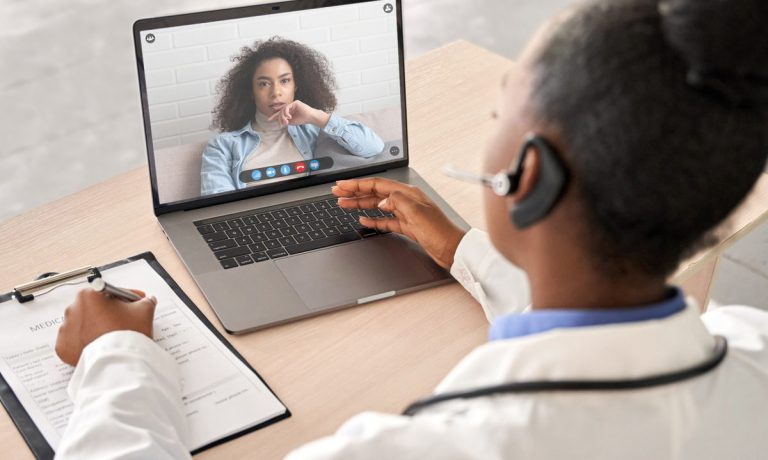Call it telehealth or telemedicine, but the concept of video doctor visits that had languished for more than a decade prior emerged as a hero of the 2020 pandemic, allowing people to interact safely with healthcare providers during long stretches of lockdowns and restrictions on in-person office visits.
After what was initially seen as a surge that would fade with the virus, we’re learning that consumers and physicians recognize the efficiencies of telehealth and now see it as a permanent fixture.
In a recent conversation with PYMNTS’ Karen Webster, MeMD CEO Bill Goodwin noted telehealth is making the most of its moment. “Now we see utilization higher than before the pandemic, and we anticipate that will continue,” he said. And there’s more to it than video chatting doctors.
With its acquisition by Walmart Health earlier this year, MeMD is now moving strategically into what’s being called “omnicare” — combining telehealth with office visits, labs and other modes of treatment — all to make healthcare more accessible and affordable.
Omnicare is a prime driver of the Walmart Health concept, and Goodwin thinks that much more can be done by adding the virtual expertise of the MeMD platform to that growing ecosystem.
“Because telehealth is becoming more of a norm, it’s pushing telehealth companies to look at … [supporting] in home health, the blood pressure cuffs, glucometers and different types of medical devices at home,” he said.
“If we’re going to deliver dermatology or second opinion or other types of services via telehealth, how do we make sure that experience is really great for both the provider and the patient?” he said. “Everyone is evolving their experiences to embrace how the delivery of healthcare is changing,” and the role telehealth now plays in expanding access.
Demand is growing. While the easing of restrictions saw millions return to in-office visits, the PYMNTS study, Connected Healthcare: What Consumers Want From Their Healthcare Customer Experiences, a Rectangle Health collaboration, found that millennials and bridge millennials — two demographic cohorts now aging into greater healthcare utilization — prefer digital options to interact with their healthcare providers, with 32% of millennials and 30% of bridge millennials expressing affinity for telehealth.
Get the study: Connected Healthcare: What Consumers Want From Their Healthcare Customer Experiences
Lowering Costs and Increasing Access
In a statement on MeMD’s acquisition, Walmart Health Executive Vice President, Health and Wellness Dr. Cheryl Pegus said, “Today, people expect omnichannel access to care, and adding telehealth to our Walmart Health care strategies allows us to provide in-person and digital care across our multiple assets and solutions.”
Success will be measured with numerous metrics, including the relatively new measure of experience the “patient/consumer” as paying customer. MeMD sees that as vital ground.
A focus on experience “really forces us and companies like us … to really make sure the experiences that people have are great via telehealth,” Goodwin told Webster.
“Telehealth won’t permanently replace the in-person component, but it can definitely help support patient need, provider availability and cost,” he said. “Typically, telehealth costs the patient a little bit less than in-person. We all know that the cost of healthcare continues to rise, so anything we can do to help patients lower their out-of-pocket expense on healthcare is a good thing.”
Lowering healthcare costs will go a long way toward improving patient/consumer experience, and combining telehealth with primary care can create even more savings along their healthcare journeys.
Goodwin said, “We know that for every dollar spent in primary care, $13 is saved down the road in terms of healthcare costs. So primary care alone is a huge kind of gateway to lowering and controlling healthcare costs because you can identify conditions early.”
Adding the statistic that one in four U.S. adults don’t have a primary care physician, he noted that “virtual primary care” is one of the biggest areas of growth MeMD is pursuing.
See also: Innovators Take Page From Amazon, Netflix to Improve Healthcare Access and Reduce Cost of Care
Omnichannel Healthcare Scales
Walmart’s scale in brick-and-mortar clinics and pharmacies bolster MeMD’s value prop further.
“One of the things that got us excited when we started talking to Walmart was their … mission,” Goodwin said. After joining the Walmart Health portfolio in the second quarter, he added that MeMD is part of that mission and “really focused towards omnichannel delivery. We want to bring the care to people in the way they want to consume it in a way that they can afford it.”
He noted that more than 100 million people enter Walmart locations daily. Given that more and more of those stores offer a robust suite of clinical services, there’s plenty of physical access to take a MeMD telehealth visit to any next steps without leaving that ecosystem.
“We all know that that healthcare is something that everyone has to consume in their life, so there’s wonderful opportunities for us to look at omnichannel in clinic, pharmacy, telehealth, vision, hearing,” Goodwin said, adding that “you probably know the stat 90% of the U.S. population lives within 10 miles of Walmart, so that also helps us get to some of these rural populations and get healthcare out to them.”
See also: CVS, Walmart Take Lead on Omnichannel Healthcare Superstores for Post-Pandemic Era




